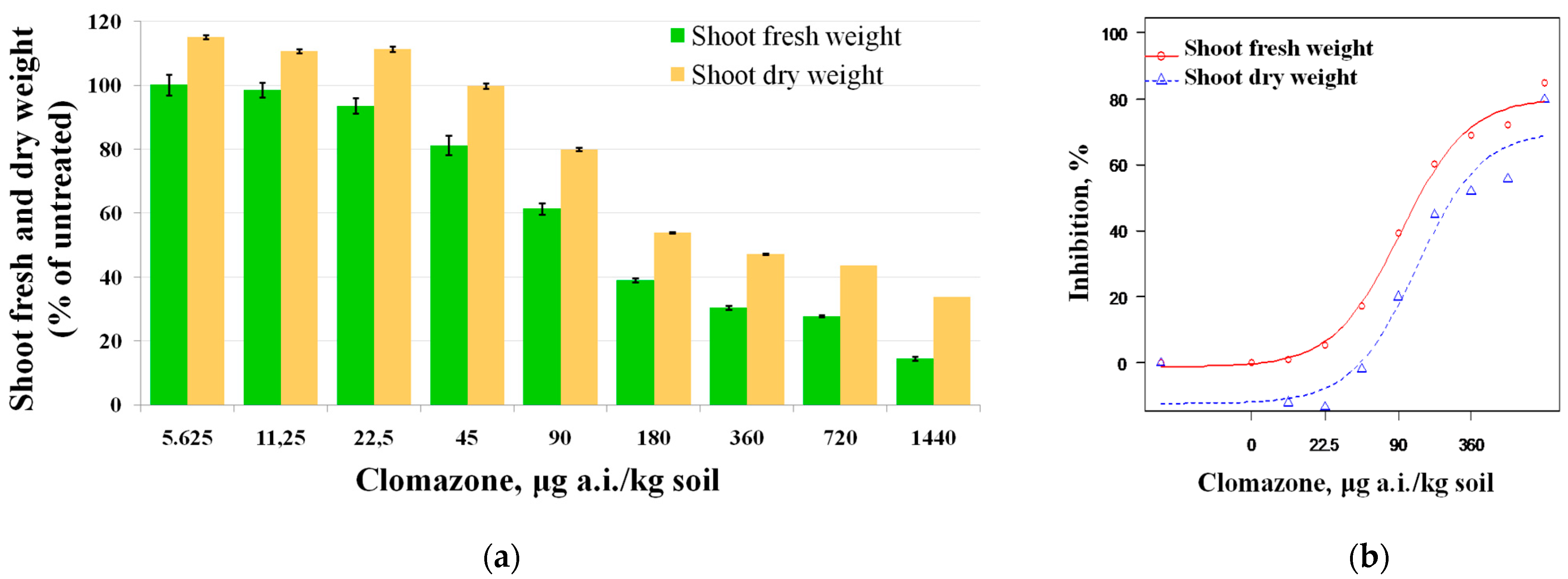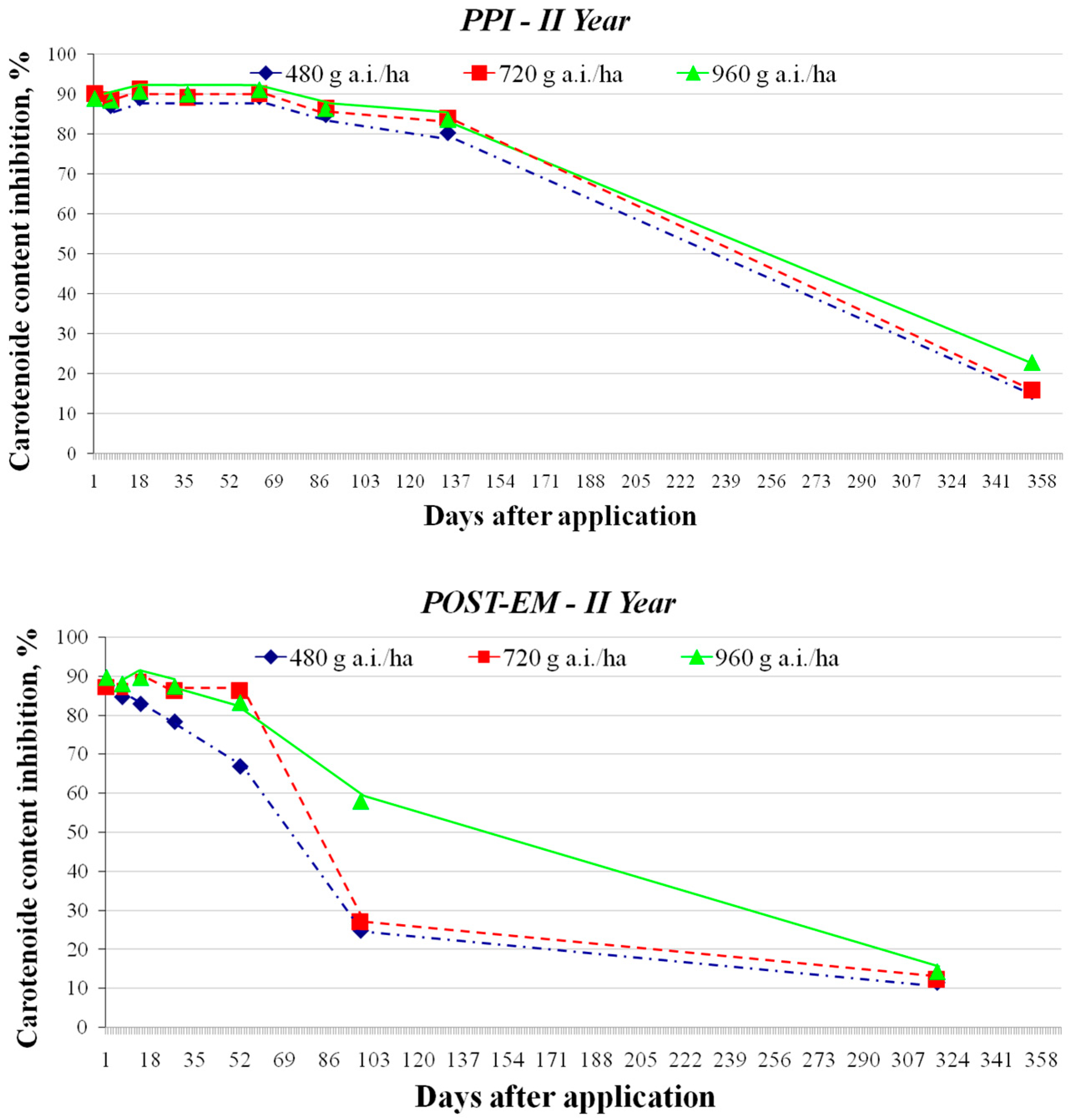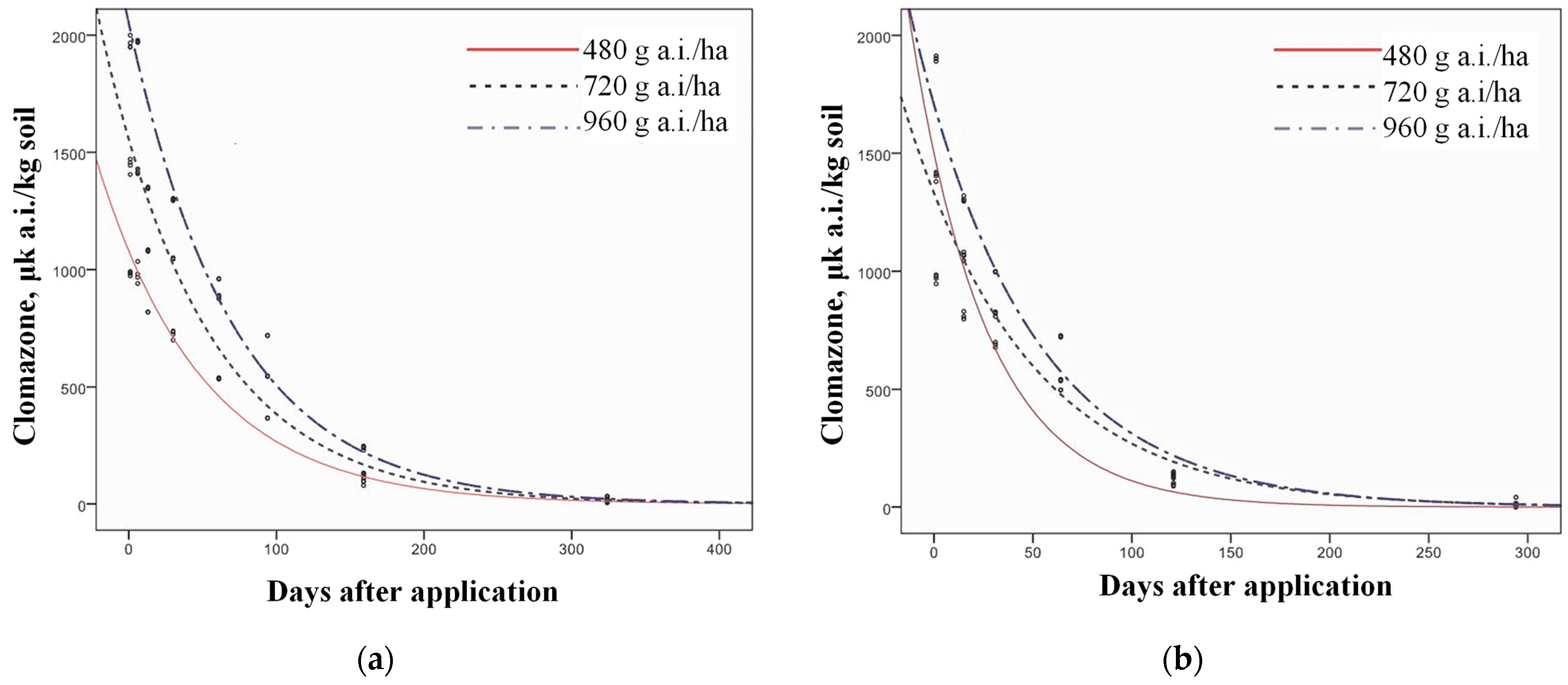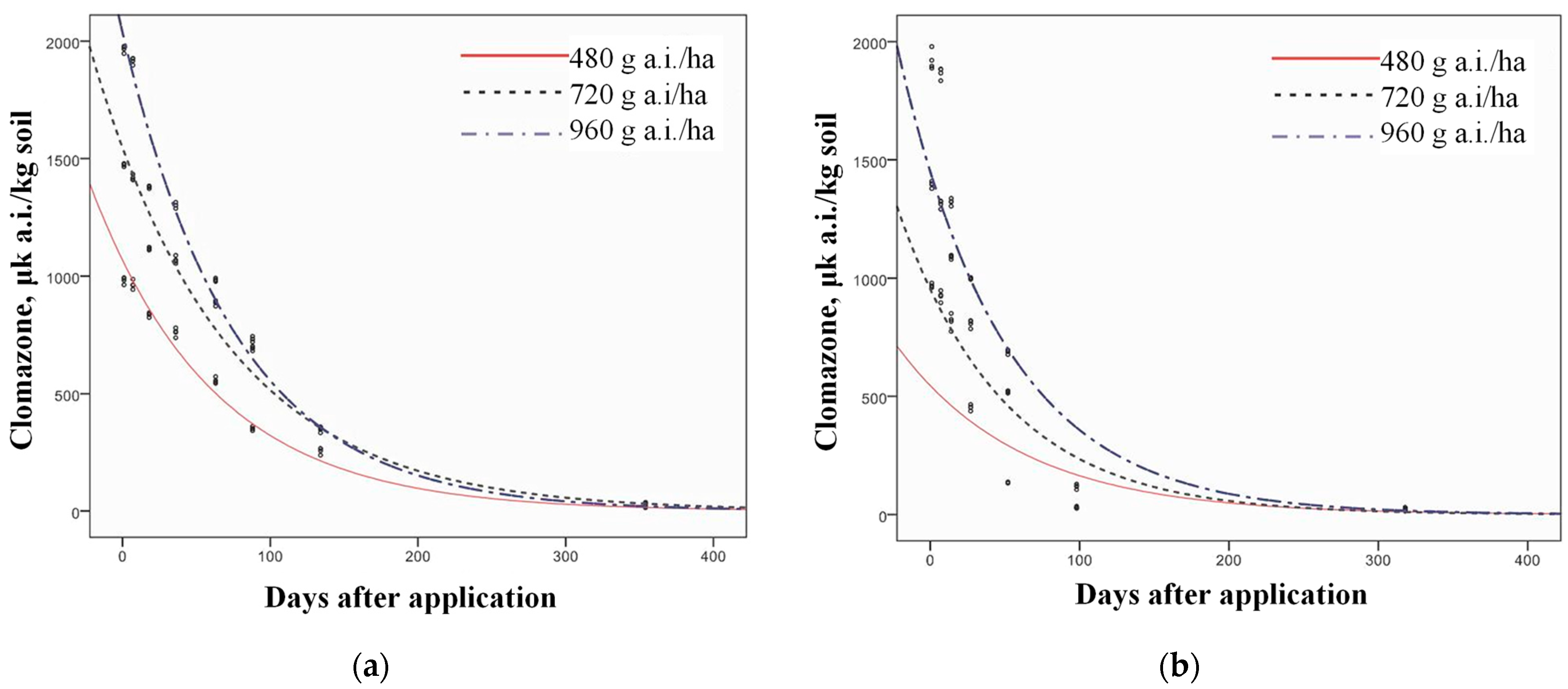Susceptibility of Different Crops to Simulated Clomazone Carry-Over and Its Degradation Dynamics in Sandy Loam Soil
Abstract
1. Introduction
2. Materials and Methods
2.1. Plant Material, Soil and Herbicide
2.2. Bioassay Under Controlled Conditions
2.3. Field Trials: Clomazone Degradation and Residue Levels in the Soil
2.4. Statistical Analyses
3. Results
3.1. Effect of Clomazone on Morphological Parameters
3.2. Effect of Clomazone on Pigment Content
3.3. Clomazone Degradation Dynamics and Residue Levels in the Soil
4. Discussion
4.1. Effect of Clomazone on Shoot Fresh and Dry Weight
4.2. Effect of Clomazone on Pigment Content (Carotenoids, Chlorophyll a and Chlorophyll b)
4.3. Clomazone Degradation Dynamics and Residue Levels in the Soil
5. Conclusions
Funding
Data Availability Statement
Acknowledgments
Conflicts of Interest
Abbreviations
| PPI | Pre-Plant Incorporated |
| POST-EM | Post-Emergence |
| SFW | Shoot Fresh Weight |
| SDW | Shoot Dry Weight |
| NOEL | No Observable Effect Level |
| ARL | Acceptable Residue Level |
| DT50 | Degradation Time (50%) i.e., half-life |
References
- Miller, T.W. Effects of several herbicides on green pea (Pisum sativum) and subsequent crops. Weed Technol. 2003, 17, 731–737. [Google Scholar] [CrossRef]
- Scherder, E.F.; Talbert, R.T.; Clark, S.D. Rice (Oryza sativa) cultivar tolerance to clomazone. Weed Technol. 2004, 18, 140–144. [Google Scholar] [CrossRef]
- Mudge, C.R.; Webster, E.P.; Leon, C.T.; Zhang, W. Rice (Oryza sativa) cultivar tolerance to clomazone in water-seeded production. Weed Technol. 2005, 19, 907–911. [Google Scholar] [CrossRef]
- Zhang, W.; Webster, E.P.; Blouin, D.C. Response of rice and barnyardgrass (Echinochloa crus-galli) to rates and timmings of clomazone. Weed Technol. 2005, 19, 528–531. [Google Scholar] [CrossRef]
- Brandenberger, L.P.; Shrefler, J.W.; Webber III, C.L.; Talbert, R.E.; Payton, M.E.; Wells, L.K.; McClelland, M. Injury potential from carryover of watermelon herbicide residues. Weed Technol. 2007, 21, 473–476. [Google Scholar] [CrossRef]
- Sikkema, P.H.; Shropshire, C.; Soltani, N. Effect of clomazone on various market classes of dry beans. Crop Prot. 2007, 26, 943–947. [Google Scholar] [CrossRef]
- Andres, A.; Concenço, G.; Theisen, G.; Vidotto, F.; Ferrero, A. Selectivity and weed control efficacy of pre- and post-emergence applications of clomazone in Southern Brazil. Crop Prot. 2013, 53, 103–108. [Google Scholar] [CrossRef]
- Carvalho, D.R.d.; Lins, H.A.; Souza, M.d.F.; Silva, T.S.; Porto, M.A.F.; Mendonça, V.; Silva, D.V. Weed control in melon with pre emergence herbicides. Pesqui. Agropecu. Bras. 2022, 57, e02334. [Google Scholar] [CrossRef]
- Westberg, D.E.; Oliver, L.R.; Frans, R.E. Weed control with clomazone alone and with other herbicides. Weed Technol. 1989, 3, 678–685. [Google Scholar] [CrossRef]
- Porter, W.C. Clomazone for weed control in sweet potatoes (Ipomea batatas). Weed Technol. 1990, 4, 648–651. [Google Scholar] [CrossRef]
- Renner, K.A.; Powell, G.E. Response of Navy bean (Phaseolus vulgaris) and wheat (Triticum aestivum) grown in rotation to clomazone, imazethapyr, bentazon and acifluorfen. Weed Sci. 1992, 40, 127–133. [Google Scholar] [CrossRef]
- Burnside, O.C.; Ahrens, W.H.; Holder, B.J.; Wiens, M.J.; Johnson, M.M.; Ristan, E.A. Efficacy and economics of various mechanical plus chemical weed control systems in dry beans (Phaseolus vulgaris). Weed Technol. 1994, 8, 238–244. [Google Scholar] [CrossRef]
- Scott, J.E.; Weston, L.A.; Jones, R.T. Clomazone for weed control in transplanted cole crops (Brassica oleracea). Weed Sci. 1995, 43, 121–127. [Google Scholar] [CrossRef]
- Ferhatogly, Y.; Barrett, M. Studies of clomazone mode of action. Pestic. Biochem. Physiol. 2006, 85, 7–14. [Google Scholar] [CrossRef]
- EFSA (European Food Safety Authority). Conclusion regarding the peer review of the pesticide risk assessment of the active substance clomazone. EFSA J. 2007, 109, e9206. [Google Scholar] [CrossRef]
- Antonius, G.F. Clomazone residues in soil and runoff: Measurement and mitigation. Bull. Environ. Contam. Toxicol. 2000, 64, 168–175. [Google Scholar] [CrossRef]
- Quayle, W.C.; Oliver, D.P.; Zrna, S. Field dissipation and environmental hazard assessment of clomazone, molinate, and thiobencarb in Australian rice culture. J. Agric. Food Chem. 2006, 54, 7213–7220. [Google Scholar] [CrossRef] [PubMed]
- Gallandt, E.R.; Fay, P.K.; Inskeep, W.P. Clomazone dissipation in two Montana soils. Weed Technol. 1989, 3, 146–150. [Google Scholar] [CrossRef]
- Loux, M.M.; Liebl, R.A.; Slife, F.W. Availability and persistence of imazaquin, imazethapyr and clomazone in soil. Weed Sci. 1989, 37, 259–267. [Google Scholar] [CrossRef]
- Loux, M.M.; Liebl, R.A.; Slife, F.W. Adsorption of clomazone on soils, sediments and clays. Weed Sci. 1989, 37, 440–444. [Google Scholar] [CrossRef]
- Kirskey, K.B.; Hayes, R.M.; Krueger, W.A.; Mullins, C.A.; Mueller, T.C. Clomazone dissipation in two Tennessee soils. Weed Sci. 1996, 44, 959–963. [Google Scholar] [CrossRef]
- Lee, D.J.; Senseman, S.A.; O’Barr, J.H.; Chandler, J.M.; Krutz, L.J.; McCauley, G.N.; Kuk, Y.I. Soil characteristics and water potential effects on plant-available clomazone in rice. Weed Sci. 2004, 52, 310–318. [Google Scholar] [CrossRef]
- Gunasekara, A.S.; Cruz, I.D.P.d.; Curtis, M.J.; Claassen, V.P.; Tjeerdema, R.S. The behavior of clomazone in the soil environment. Pest Manag. Sci. 2009, 65, 711–716. [Google Scholar] [CrossRef]
- Đurović-Pejčev, R.; Radmanović, S.B.; Tomić, Z.P.; Kaluđerović, L.M.; Bursić, V.P.; Šantrić, L.J.R. Adsorption-desorption behavior of clomazone in Regosol and Chernozem agricultural soils. J. Serb. Chem. Soc. 2020, 85, 809–819. [Google Scholar] [CrossRef]
- Cao, D.; Peng, W.; Xu, H.; Fu, X.; Gong, X.; Yu, S.; Wei, H.; Zhou, Q.; Huang, Y. Bioavailability and phytotoxicity of clomazone to corn depend on soil characteristics and can be estimated by in situ pore water. Pest Manag. Sci. 2025, 81, 1316–1323. [Google Scholar] [CrossRef] [PubMed]
- Cumming, J.P.; Doyle, R.B.; Brown, P.H. Clomazone dissipation in four Tasmanian topsoils. Weed Sci. 2002, 50, 405–409. [Google Scholar] [CrossRef]
- Gunsolus, J.L.; Bahrens, R.; Lueschen, W.E.; Warnes, D.D.; Wiersma, J.V. Carryover potential of AC-263,449, DPX-F6025, FMC-57020 and imazaquin in Minnesota. Proc. North Cent. Weed Sci. Soc. 1986, 41, 52. [Google Scholar]
- Ahrens, W.H.; Fuerst, P. Carryover injury of clomazone applied in soybeans (Glycine max) and fallow. Weed Technol. 1990, 4, 855–861. [Google Scholar] [CrossRef]
- Wang, K.; Ren, Y.; Pan, X.; Wu, X.; Xu, J.; Zheng, Y.; Dong, F. Insights on persistent herbicides in cropland soils in northern China: Occurrence, ecological risks, and phytotoxicity to subsequent crops. J. Hazard. Mater. 2025, 490, 137794. [Google Scholar] [CrossRef]
- Halsted, S.J.; Harvey, R.G. Effect of rate and carrier on clomazone movement off-site. Weed Technol. 1988, 2, 179–182. [Google Scholar] [CrossRef]
- Thelen, K.D.; Kells, J.J.; Penner, D. Comparison of application methods and tillage practices on volatilization of clomazone. Weed Technol. 1988, 2, 323–326. [Google Scholar] [CrossRef]
- Mills, J.A.; Witt, W.W. Efficacy, phytotoxicity and persistence of imazaquin, imazethapyr and clomazone in no-till double-crop soybean (Glycine max). Weed Sci. 1989, 37, 353–359. [Google Scholar] [CrossRef]
- Curran, W.S.; Knake, E.L.; Liebl, R.A. Corn (Zea mays) injury following use of clomazone, chlorimuron, imazaquin and imazethapyr. Weed Technol. 1991, 5, 539–544. [Google Scholar] [CrossRef]
- Curran, W.S.; Loux, M.M.; Liebl, R.A.; Simmons, F.W. Effect of tillage and application method on clomazone, imazaquine and imazethapyr persistence. Weed Sci. 1992, 40, 482–489. [Google Scholar] [CrossRef]
- Mervosh, T.L.; Sims, G.K.; Stoller, E.W.; Ellsworth, T.R. Clomazone sorption in soil: Incubation time, temperature and soil moisture effects. J. Agric. Food Chem. 1995, 43, 2295–2300. [Google Scholar] [CrossRef]
- Mervosh, T.L.; Sims, G.K.; Stoller, E.W. Clomazone fate in soil as affected by microbial activity, temperature and soil moisture. J. Agric. Food Chem. 1995, 43, 537–543. [Google Scholar] [CrossRef]
- Liu, S.Y.; Shocken, M.; Rosazza, J.P.N. Microbial transformation of clomazone. J. Agric. Food Chem. 1996, 44, 313–319. [Google Scholar] [CrossRef]
- Wang, H.; Ren, W.; Xu, Y.; Wang, X.; Ma, J.; Sun, Y.; Hu, W.; Chen, S.; Dai, S.; Song, J.; et al. Long-term herbicide residues affect soil multifunctionality and the soil microbial community. Ecotoxicol. Environ. Saf. 2024, 283, 116783. [Google Scholar] [CrossRef]
- Šunjka, D.; Pucarević, M.; Lazić, S.; Stojić, N.; Milošević, L.; El Bilali, H.; Berjan, S.; Šušnjar, A.; Ećimović, J. Monitoring of herbicide residues in agricultural soils in Vojvodina Province (Northern Serbia). Land 2024, 13, 1347. [Google Scholar] [CrossRef]
- Krausz, R.F.; Kapusta, G.; Knake, E.L. Soybean (Glycine max) and rotational crop tolerance to chlorimuron, clomazone, imazaquin and imazethapyr. Weed Technol. 1992, 6, 77–80. [Google Scholar] [CrossRef]
- Krausz, R.F.; Kapusta, G.; Matthews, J.L. Soybean (Glycine max) and rotational crop response to PPI chlorimuron, clomazone, imazaquin and imazethapyr. Weed Technol. 1994, 8, 224–230. [Google Scholar] [CrossRef]
- Mills, J.A.; Witt, W.W.; Barrett, M. Effects of tillage on the efficacy and persistence of clomazone in soybean (Glycine max). Weed Sci. 1989, 37, 217–222. [Google Scholar] [CrossRef]
- Monks, C.D.; Banks, P.A. Rotational crop response to chlorimuron, clomazone and imazaquin applied the previous year. Weed Sci. 1991, 39, 629–633. [Google Scholar] [CrossRef]
- Walsh, J.D.; Defelice, M.S.; Sims, B.D. Soybean (Glycine max) herbicide carryover to grain and fiber crops. Weed Technol. 1993, 7, 625–632. [Google Scholar] [CrossRef]
- Gheno, E.A.; Oliveira JR, R.S.; Constantin, J.; Takano, H.K.; Gemelli, A. Residual activity of herbicides applied to cotton on crops cultivated in succession. Rev. Caatinga 2016, 29, 143–152. [Google Scholar] [CrossRef][Green Version]
- Renner, K.A.; Powell, G.E. Response of sugar beet (Beta vulgaris) to herbicide residues in soil. Weed Technol. 1991, 5, 622–627. [Google Scholar] [CrossRef]
- Walsh, J.D.; Defelice, M.S.; Sims, B.D. Influence of tillage on soybean (Glycine max) herbicide carryover to grass and legume forage crops in Missouri. Weed Sci. 1993, 41, 144–149. [Google Scholar] [CrossRef]
- Gheno, E.A.; Oliveira JR, R.S.; Constantin, J.; Biffe, D.F.; Menezes, C.C.E.; Franchini, L.H.M.; Osipe, J.B.; Raimondi, R.T. Carryover of herbicides applied in the pre-emergence of cotton on the corn grown in succession. Rev. Bras. Herb. 2015, 14, 155–163. [Google Scholar] [CrossRef]
- Mervosh, T.L.; Stoller, E.W.; Simmons, F.W.; Ellsworth, T.R.; Sims, G.K. Effects of starch encapsulation on clomazone and atrazine movement in soil and clomazone volatilization. Weed Sci. 1995, 43, 445–453. [Google Scholar] [CrossRef]
- Johnson, D.H.; Beaty, J.D.; Horton, D.K.; Talbert, R.E.; Guy, C.B.; Mattice, J.D.; Lavy, T.L.; Smith, R.J., Jr. Effects of rotational crop herbicides on rice (Oryza sativa). Weed Sci. 1995, 43, 648–654. [Google Scholar] [CrossRef]
- Pintar, A.; Stipičeić, S.; Lakić, J.; Barić, K. Phytotoxicity of Mesotrione Residues on Sugar Beet (Beta vulgaris L.) in Agricultural Soils Differing in Adsorption Affinity. Sugar Tech. 2020, 22, 137–142. [Google Scholar] [CrossRef]
- Pintar, A.; Svečnjak, Z.; Lakić, J.; Magdić, I.; Brzoja, D.; Barić, K. The Susceptibility of Pea (Pisum sativum L.) to Simulated Mesotrione Residues as Affected by Soil pH Manipulation. Agriculture 2021, 11, 688. [Google Scholar] [CrossRef]
- Pismarović, L.; Milanović-Litre, A.; Kljak, K.; Lazarević, B.; Šćepanović, M. Soil solution pH can affect the response of the common bean (Phaseolus vulgaris L.) to mesotrione residues. Plant Soil Environ. 2022, 68, 237–244. [Google Scholar] [CrossRef]
- Wellburn, A.R. The special determinations of chlorophylls a and b, as well as total carotenoids, using various solvents with spectrophotometers of different resolution. J. Plant Physiol. 1994, 144, 307–313. [Google Scholar] [CrossRef]
- R Development Core Team. R: A Language and Environment for Statistical Computing; R Foundation for Statistical Computing: Vienna, Austria, 2009; ISBN 3-900051-07-0. Available online: http://www.R-project.org (accessed on 15 April 2025).
- Pestemer, W.; Günther, P. No-observable Effect Level (NOEL). In Herbicide Bioassays; Streibig, J.C., Kudsk, P., Eds.; CRC Press: Boca Raton, FL, USA, 1993; pp. 137–152. [Google Scholar]
- Onofri, A. Biological activity, field persistence and safe recroping intervals for imazethapyr and rimsulfuron on a silty-clay soil. Weed Res. 1996, 36, 73–83. [Google Scholar] [CrossRef]
- Pannacci, E.; Onofri, A.; Covarelli, G. Biological activity, availability and duration of phytotoxicity for imazamox in four different soils of central Italy. Weed Res. 2006, 46, 243–250. [Google Scholar] [CrossRef]
- Jovanović-Radovanov, K.; Rančić, D. Susceptibility of selected crops to simulated imazethapyr carryover: A morpho-anatomical analysis. Agronomy 2023, 13, 1857. [Google Scholar] [CrossRef]
- Horowitz, M. Application of bioassay techniques to herbicide investigations. Weed Res. 1976, 16, 209–215. [Google Scholar] [CrossRef]
- Weston, L.A.; Barrett, M. Tolerance of tomato (Lycopersicon esculentum) and bell pepper (Capsicum annum) to clomazone. Weed Sci. 1989, 37, 285–289. [Google Scholar] [CrossRef]
- Vrbničanin, S.; Božić, D.; Rančić, D.; Jovanović-Radovanov, K. Susceptibility of different varieties of Canada thistle (Cirsium arvense (L.) Scop.) to some herbicides. Acta Herbol. 2004, 13, 457–464. [Google Scholar]
- Locke, A.M.; Smeda, R.J.; Howard, K.D.; Reddy, K.N. Clomazone volatilization under varying environmental conditions. Chemosphere 1996, 33, 1213–1225. [Google Scholar] [CrossRef]
- Basham, G.; Lavy, T.L. Microbial and photolytic dissipation of imazaquin in soil. Weed Sci. 1987, 35, 865–870. [Google Scholar] [CrossRef]
- Szpyrka, E.; Słowik-Borowiec, M.; Książek, P.; Zwolak, A.; Podbielska, M. The difference in dissipation of clomazone and metazachlor in soil under field and laboratory conditions and their uptake by plants. Sci. Rep. 2020, 10, 3747. [Google Scholar] [CrossRef] [PubMed]
- Gallaher, K.; Mueller, T.C. Effects of crop presence on persistence of atrazine, metribuzin and clomazone in surface soil. Weed Sci. 1996, 44, 698–703. [Google Scholar] [CrossRef]







| YEAR I | YEAR II | ||
|---|---|---|---|
| Date/DAA 1 | Date/DAA 1 | ||
| PPI | POST-EM | PPI | POST-EM |
| 09.04.2015./0 | 10.05.2015./0 | 23.04.2017./0 | 26.05.2017./0 |
| 16.04.2015./7 | 24.05.2015./14 | 30.04.2017./7 | 02.06.2017./7 |
| 24.04.2015./15 | 09.06.2015./30 | 10.05.2017./17 | 10.06.2017./15 |
| 09.05.2015./30 | 11.07.2015./62 | 29.05.2017./36 | 25.06.2017./30 |
| 06.06.2015./61 | 13.09.2015./126 | 25.06.2017./63 | 22.07.2017./57 |
| 11.07.2015./93 | 27.02.2016./293 | 22.07.2017./90 | 05.09.2017./102 |
| 13.09.2015./157 | 18.04.2016./345 | 05.09.2017./135 | 14.04.2018./324 |
| 27.02.2016./324 | 14.04.2018./356 | ||
| 18.04.2016./375 | |||
| 2015/2016 | Average per Quarter | 2017/2018 | Average per Quarter | Average for 50 Years | Average per Quarter | |
|---|---|---|---|---|---|---|
| April | 26.0 | 198.3 | 55.2 | 220.5 | 48.7 | 255.6 |
| May | 73.1 | 45.2 | 63.2 | |||
| Jun | 50.8 | 50.8 | 81.0 | |||
| July | 48.4 | 69.3 | 62.7 | |||
| August | 75.6 | 347.0 | 25.4 | 176.8 | 56.4 | 208.8 |
| September | 92.8 | 73.7 | 50.4 | |||
| October | 92.2 | 21.6 | 52.1 | |||
| November | 86.4 | 56.1 | 49.9 | |||
| December | 32.1 | 140.3 | 49.3 | 127.6 | 43.3 | 158.5 |
| January | 26.1 | 49.1 | 38.9 | |||
| February | 27.7 | 21.1 | 35.8 | |||
| March | 54.4 | 8.1 | 40.5 | |||
| Sum | 685.6 | 524.9 | 622.9 |
| Parameter Measured | Regression Parameters (±SE) | EC50 | EC20 | EC10 | ||
|---|---|---|---|---|---|---|
| B | D | C | ||||
| SFW | −1.6 (0.4) | 80.3 (4.9) | −1.2 (3.3) | 94.6 (14.7) | 39.1 (8.4) | 23.3 (7.2) |
| SDW | −1.6 (0.4) | 70.3 (6.0) | −12.3 (2.8) | 128.2 (23.2) | 54.8 (9.3) | 33.4 (8.3) |
| Plant Species | Parameter Measured | Regression Parameters (±SE) | EC50 | EC20 | EC10 | ||
|---|---|---|---|---|---|---|---|
| B | D | C | |||||
| Maize | CAR. | −1.3 (0.2) | 116.1 (14.1) | −2.6 (1.7) | 527.3 (112.2) | 187.6 (21.4) | 102.5 (14.7) |
| Chl. a | −1.4 (0.2) | 117.7 (11.2) | −2.3 (1.7) | 456.1 (74.9) | 170.0 (16.9) | 95.5 (13.9) | |
| Chl. b | 1.4 (0.2) | 120.4 (13.5) | −2.5 (1.7) | 535.8 (100.8) | 201.8 (20.7) | 114.0 (15.2) | |
| Sunflower * | CAR. | −1.6 (0.1) | − | −1.6 (1.5) | 417.5 (22.6) | 71.8 (14.6) | 51.9 (17.4) |
| Chl. a | −1.8 (0.2) | − | −0.9 (1.5) | 359.7 (19.0) | 69.0 (13.9) | 35.7 (13.6) | |
| Chl. b | −1.8 (0.2) | − | −1.3 (1.5) | 409.1 (22.8) | 93.2 (19.6) | 58.5 (13.1) | |
| Wheat | CAR. | −1.4 (0.2) | 99.1 (5.1) | 2.6 (2.1) | 214.4 (23.5) | 80.4 (11.5) | 45.3 (9.5) |
| Chl. a | −1.4 (0.2) | 106.8 (5.7) | −0.3 (2.1) | 233.9 (26.3) | 83.8 (10.7) | 46.0 (8.6) | |
| Chl. b | −1.5 (0.2) | 105.1 (5.4) | 1.2 (2.0) | 243.8 (24.8) | 95.9 (11.8) | 55.6 (10.1) | |
| Sugar beet | CAR. | −1.4 (0.1) | 94.4 (2.5) | −4.0 (2.6) | 45.9 (4.1) | 17.3 (2.2) | 9.8 (1.7) |
| Chl. a | −1.4 (0.1) | 99.9 (2.5) | −3.8 (2.6) | 47.4 (4.1) | 17.5 (2.1) | 9.7 (1.6) | |
| Chl. b | −1.4 (0.1) | 100.1 (2.5) | −3.1 (2.6) | 45.8 (3.9) | 17.1 (2.1) | 9.6 (1.6) | |
| White mustard | CAR. | −1.5 (0.1) | 89.0 (2.0) | −6.5(2.0) | 57.5 (4.2) | 22.9 (2.3) | 13.4 (1.8) |
| Chl. a | −1.2 (0.1) | 101.2 (2.4) | −5.0 (2.2) | 59.1 (4.8) | 19.3 (2.1) | 10.0 (1.5) | |
| Chl. b | −1.2 (0.1) | 102.6 (2.7) | −4.7 (2.2) | 63.3 (5.5) | 19.2 (2.2) | 9.5 (1.5) | |
| Type of Application | Application Rate g a.i./ha | Year I (2015/2016) | Year II (2017/2018) | ||
|---|---|---|---|---|---|
| PPI | 480 | Y = 1079.684 × e−0.014X | 0.960 | Y = 1067.671 × e−0.012X | 0.995 |
| 720 | Y = 1555.373 × e−0.014X | 0.976 | Y = 1546.129 × e−0.011X | 0.994 | |
| 960 | Y = 2050.568 × e−0.014X | 0.984 | Y = 2036.773 × e−0.013X | 0.997 | |
| POST-EM | 480 | Y = 1499.506 × e−0.026X | 0.959 | Y = 545.242 × e−0.012X | 0.671 |
| 720 | Y = 1330.783 × e−0.016X | 0.949 | Y = 952.927 × e−0.014X | 0.739 | |
| 960 | Y = 1706.018 × e−0.017X | 0.943 | Y = 1449.845 × e−0.014X | 0.906 | |
| Experimental Year | Type of Application | Application Rate g a.i./ha | DT50 (Days) | Average DT50 (Days) | |
|---|---|---|---|---|---|
| YEAR I (2015/2016) | PPI | 480 | 49.5 | 49.5 | 43 |
| 720 | 49.5 | ||||
| 960 | 49.5 | ||||
| POST-EM | 480 | 26.7 | 37 | ||
| 720 | 43.3 | ||||
| 960 | 40.8 | ||||
| YEAR II (2017/2018) | PPI | 480 | 57.8 | 58 | 55 |
| 720 | 63.0 | ||||
| 960 | 53.3 | ||||
| POST-EM | 480 | 57.8 | 52 | ||
| 720 | 49.5 | ||||
| 960 | 49.5 | ||||
| Type of Application | Application Rate g a.i./ha | YEAR I (2015/2016) | YEAR II (2017/2018) | ||||||||
|---|---|---|---|---|---|---|---|---|---|---|---|
| CCI (%) | Clo. μg a.i./kg | CCI (%) | Clo. μg a.i./kg | CCI (%) | Clo. μg a.i./kg | CCI (%) | Clo. μg a.i./kg | CCI (%) | Clo. μg a.i./kg | ||
| 157 DAA | 324 DAA | 375 DAA | 135 DAA | 356 DAA | |||||||
| PPI | 480 | 58.4 | 70.76 | 3.43 | 12.43 | 0.0 | ND | 80.4 | 97.42 | 15.53 | 21.04 |
| 720 | 63.1 | 76.45 | 10.67 | 15.73 | 0.0 | ND | 84.0 | 101.78 | 22.89 | 34.35 | |
| 960 | 75.0 | 90.88 | 20.57 | 23.14 | 0.37 | 0.49 | 83.7 | 99.47 | 15.91 | 21.63 | |
| 126 DAA | 293 DAA | 345 DAA | 102 DAA | 324 DAA | |||||||
| POST-EM | 480 | 57.6 | 69.79 | 0.49 | 0.95 | 0.0 | ND | 25.4 | 37.74 | 11.53 | 17.47 |
| 720 | 63.7 | 77.19 | 3.29 | 11.7 | 0.0 | ND | 27.0 | 39.67 | 14.27 | 18.87 | |
| 960 | 67.8 | 79.2 | 5.29 | 13.09 | 0.42 | 0.95 | 58.0 | 70.32 | 12.16 | 17.7 | |
Disclaimer/Publisher’s Note: The statements, opinions and data contained in all publications are solely those of the individual author(s) and contributor(s) and not of MDPI and/or the editor(s). MDPI and/or the editor(s) disclaim responsibility for any injury to people or property resulting from any ideas, methods, instructions or products referred to in the content. |
© 2025 by the author. Licensee MDPI, Basel, Switzerland. This article is an open access article distributed under the terms and conditions of the Creative Commons Attribution (CC BY) license (https://creativecommons.org/licenses/by/4.0/).
Share and Cite
Jovanović-Radovanov, K. Susceptibility of Different Crops to Simulated Clomazone Carry-Over and Its Degradation Dynamics in Sandy Loam Soil. Agronomy 2025, 15, 1538. https://doi.org/10.3390/agronomy15071538
Jovanović-Radovanov K. Susceptibility of Different Crops to Simulated Clomazone Carry-Over and Its Degradation Dynamics in Sandy Loam Soil. Agronomy. 2025; 15(7):1538. https://doi.org/10.3390/agronomy15071538
Chicago/Turabian StyleJovanović-Radovanov, Katarina. 2025. "Susceptibility of Different Crops to Simulated Clomazone Carry-Over and Its Degradation Dynamics in Sandy Loam Soil" Agronomy 15, no. 7: 1538. https://doi.org/10.3390/agronomy15071538
APA StyleJovanović-Radovanov, K. (2025). Susceptibility of Different Crops to Simulated Clomazone Carry-Over and Its Degradation Dynamics in Sandy Loam Soil. Agronomy, 15(7), 1538. https://doi.org/10.3390/agronomy15071538






